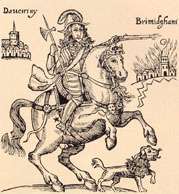Who was afraid of Prince Rupert's dog?: The enduring power of seventeenth-century propaganda

Research by an historian at the University of Southampton has revealed how modern scholars have been led astray by a 350-year-old propaganda campaign.
Popular histories of the English Civil War of 1642-46 – fought between the Royalists and the Parliamentarians - make frequent reference to a dog named ‘Boy’, which belonged to King Charles I’s nephew Prince Rupert. The authors of these histories confidently state that Boy was believed by the Parliamentarians to be a ‘dog-witch’ who was in league with the devil.
Until now, it has been generally accepted that Parliamentarian soldiers were terrified of this animal and that they quaked at the thought of going into battle against Prince Rupert and his sinister canine companion. However, research by Professor Mark Stoyle has revealed that the idea that the Parliamentarians were petrified of Boy was, in fact, an invention of the Royalists: an early example of wartime propaganda.
Mark comments, “It was the Parliamentarians themselves who were the first to hint that Rupert possessed occult powers, in an attempt to paint the Royalist cause as literally ‘satanic’. But their plan backfired when Royalists took up their enemies’ claims, exaggerated them and used them to their own advantage in order to portray the Parliamentarians as gullible fools.”
This process began with the Royalist writer John Cleveland, who mocked the King’s enemies in a satirical poem, which not only declared that the Parliamentarians believed Rupert to possess magical powers, but also suggested that they viewed the prince’s dog as his ‘devil’ or ‘familiar spirit’.
Cleveland’s poem was swiftly followed by a fake Parliamentarian pamphlet – in fact produced by a Royalist writer – which listed the powers Boy was claimed to possess, including one suggestion that he was able to catch bullets in his mouth. Thereafter, fantastical stories about Boy continued to spread until Rupert was defeated at the battle of Marston Moor in 1644 and his famous dog was killed. The Parliamentarians won the Civil War two years later.
Mark says, “During the course of my research, I’ve found very little evidence to suggest that the belief that Boy was a ‘familiar spirit’ was genuinely widespread in the Parliamentarian camp. Instead, it was the Victorian rediscovery of the mischievous satires, which the Royalists had written about Boy, which led to the claim that the Parliamentarians had been terrified of Prince Rupert’s dog – a claim which was written into the history books.”
“Thus the myth of the magical prince and his ‘devil dog’ demonstrates the power of seventeenth-century propaganda to confuse and deceive us, even to this day.”
More information: The strange story of Prince Rupert’s dog (thought to be a hunting-poodle) began in 1642, when Charles I summoned his nephew to assist him against his enemies in Parliament. Rupert was swift to answer his uncle’s call, and was made General of the Royalist cavalry. As the King’s army advanced on London, Parliamentarians grew increasingly shrill in their denunciations of the foreign prince who marched at the head of the Royalist forces.
Provided by University of Southampton

















